Implementation of Construction Waste Recycling under Construction Sustainability Incentives: A Multi-Agent Stochastic Evolutionary Game Approach
Abstract
:1. Introduction
- The three-party stochastic game structure, which includes government agencies, construction waste producers, and construction waste recyclers, is first presented.
- The Lyapunov exponent diagram is next analyzed to capture the nonlinear dynamic behavior of the replicator dynamic equation based on Benettin method.
- Next, the Gaussian white noise is inserted into the replicator dynamic equation as an uncertain that exists in the external environment. Furthermore, the existence and stability of the equilibrium solutions of the stochastic differential equation are investigated.
- Finally, the numerical simulations are conducted to show the evolutionary trajectory in terms of the stability based on Taylor expansion.
2. Literature Review
2.1. Construction Waste Recycling and Management
2.2. Evolutionary Game Theory for Construction Waste
3. Three-Party Evolutionary Game Framework
3.1. Problem Formulation
- The government agencies, waste recyclers, and waste producers have individually bounded rationality and try to find the maximization value of their interests.
- The waste recyclers have enough spaces to recycle waste if the waste producers are “conducting” waste recycling strategy.
- They are able to adjust their strategies when the environment changes in the construction waste recycling process.
- Assuming x indicates the probability when government agency conducts positive supervision, denotes the probability when government agency conducts negative supervision. Similarly, y denotes the probability that waste recyclers conduct construction waste recycling, indicates the probability that waste recyclers do not conduct construction waste recycling. If z denotes the probability that waste producers implement construction waste recycling, represents the probability that waste producers do not implement construction waste recycling.
- In the stochastic evolutionary system, the higher the strategy payoff than the average payoff is, the higher probability different enterprises conduct this strategy. Generally, this principle can be represented by replicator dynamics formulas.
- The uncertainty exists around different participants, which will bring random disturbance into the evolutionary system. To this end, it is necessary to consider this random noise in the replication dynamic differential formula.
3.2. Payoff Matrix and Replicator Dynamics Equations
3.3. Replicator Dynamics Analysis
3.4. Nonlinear Dynamic System Chaotic Analysis
4. Stochastic Evolutionary Game Framework
4.1. Multi-Agent Stochastic Evolutionary Game Framework
4.2. Equilibrium Solutions Analysis
4.3. Taylor Expansion of Evolution Equation
5. Numerical Simulations
5.1. Sorting Cost of Construction Waste
5.2. Disposal Costs from Waste Producers
5.3. Effects of Effort Level of Waste Producers
5.4. The Effect of Noise Intensity
6. Discussion
- With the construction waste recycling system, greater attention must be paid to the game interaction between waste producers and waste recyclers. Different enterprises have different willingness in different states, which makes the behavior of participants in the construction waste recycling system more complicated. It is therefore incredibly important to coordinate the different waste recycling enterprises’ interests and obligations to ensure the effective implementation of waste recycling and to improve environmental quality.
- As regulators of the construction waste recycling system, the government agency must adopt a subsidy-penalty coordination mechanism in order to improve construction waste recycling’s environmental quality and increase subsidies for qualified recyclers and default penalties for collusion.
- When making decisions, the government agency must fully consider the existence of uncertain factors in order to ensure the smooth implementation of environmental incentive policies and improve construction waste recycling quality.
7. Conclusions
Author Contributions
Funding
Institutional Review Board Statement
Informed Consent Statement
Data Availability Statement
Conflicts of Interest
References
- Ma, L.; Zhang, L. Evolutionary game analysis of construction waste recycling management in China. Resour. Conserv. Recycl. 2020, 161, 104863. [Google Scholar] [CrossRef]
- Multiagent evolutionary game in the recycling utilization of construction waste. Sci. Total. Environ. 2020, 738, 139826. [CrossRef] [PubMed]
- Zheng, L.; Wu, H.; Zhang, H.; Duan, H.; Wang, J.; Jiang, W.; Dong, B.; Liu, G.; Zuo, J.; Song, Q. Characterizing the generation and flows of construction and demolition waste in China. Constr. Build. Mater. 2017, 136, 405–413. [Google Scholar] [CrossRef] [Green Version]
- Li, X.; Huang, R.; Dai, J.; Li, J.; Shen, Q. Research on the evolutionary game of construction and demolition waste (CDW) recycling units’ green behavior, considering remanufacturing capability. Int. J. Environ. Res. Public Health 2021, 18, 9268. [Google Scholar] [CrossRef] [PubMed]
- Tseng, M.L.; Wong, W.P.; Soh, K.L. An overview of the substance of resource, conservation and recycling. Resour. Conserv. Recycl. 2018, 136, 367–375. [Google Scholar] [CrossRef]
- Gálvez-Martos, J.L.; Styles, D.; Schoenberger, H.; Zeschmar-Lahl, B. Construction and demolition waste best management practice in Europe. Resour. Conserv. Recycl. 2018, 136, 166–178. [Google Scholar] [CrossRef] [Green Version]
- Huang, B.; Wang, X.; Kua, H.; Geng, Y.; Bleischwitz, R.; Ren, J. Construction and demolition waste management in China through the 3R principle. Resour. Conserv. Recycl. 2018, 129, 36–44. [Google Scholar] [CrossRef]
- Wang, H.; She, H.; Xu, J.; Liang, L. A Three-Point Hyperbolic Combination Model for the Settlement Prediction of Subgrade Filled with Construction and Demolition Waste. Materials 2020, 13, 1959. [Google Scholar] [CrossRef]
- Kabirifar, K.; Mojtahedi, M.; Wang, C.; Tam, V.W. Construction and demolition waste management contributing factors coupled with reduce, reuse, and recycle strategies for effective waste management: A review. J. Clean. Prod. 2020, 263, 121265. [Google Scholar] [CrossRef]
- Bakshan, A.; Srour, I.; Chehab, G.; El-Fadel, M.; Karaziwan, J. Behavioral determinants towards enhancing construction waste management: A Bayesian Network analysis. Resour. Conserv. Recycl. 2017, 117, 274–284. [Google Scholar] [CrossRef]
- Fu, J.; Zhong, J.; Chen, D.; Liu, Q. Urban environmental governance, government intervention, and optimal strategies: A perspective on electronic waste management in China. Resour. Conserv. Recycl. 2020, 154, 104547. [Google Scholar] [CrossRef]
- Tam, V.W.; Le, K.N.; Wang, J.; Illankoon, I. Practitioners recycling attitude and behaviour in the Australian construction industry. Sustainability 2018, 10, 1212. [Google Scholar] [CrossRef] [Green Version]
- Long, H.; Liu, H.; Li, X.; Chen, L. An evolutionary game theory study for construction and demolition waste recycling considering green development performance under the chinese government’s reward–penalty mechanism. Int. J. Environ. Res. Public Health 2020, 17, 6303. [Google Scholar] [CrossRef] [PubMed]
- Du, L.; Feng, Y.; Lu, W.; Kong, L.; Yang, Z. Evolutionary game analysis of stakeholders’ decision-making behaviours in construction and demolition waste management. Environ. Impact Assess. Rev. 2020, 84, 106408. [Google Scholar] [CrossRef]
- Foster, D.; Young, P. Stochastic evolutionary game dynamics. Theor. Popul. Biol. 1990, 38, 219–232. [Google Scholar] [CrossRef] [Green Version]
- Li, J.; Ren, H.; Zhang, C.; Li, Q.; Duan, K. Substantive innovation or strategic innovation? Research on multiplayer stochastic evolutionary game model and simulation. Complexity 2020, 2020, 9640412. [Google Scholar] [CrossRef]
- Duan, H.; Li, J. Construction and demolition waste management: China’s lessons. Waste Manag. Res. 2016, 34, 397–398. [Google Scholar] [CrossRef] [Green Version]
- Yang, H.; Xia, J.; Thompson, J.R.; Flower, R.J. Urban construction and demolition waste and landfill failure in Shenzhen, China. Waste Manag. 2017, 63, 393–396. [Google Scholar] [CrossRef]
- Kabirifar, K.; Mojtahedi, M.; Wang, C.C.; Tam, V.W. Effective construction and demolition waste management assessment through waste management hierarchy; a case of Australian large construction companies. J. Clean. Prod. 2021, 312, 127790. [Google Scholar] [CrossRef]
- Ghafourian, K.; Kabirifar, K.; Mahdiyar, A.; Yazdani, M.; Ismail, S.; Tam, V.W. A synthesis of express analytic hierarchy process (EAHP) and partial least squares-structural equations modeling (PLS-SEM) for sustainable construction and demolition waste management assessment: The case of Malaysia. Recycling 2021, 6, 73. [Google Scholar] [CrossRef]
- Bao, Z.; Lu, W. A decision-support framework for planning construction waste recycling: A case study of Shenzhen, China. J. Clean. Prod. 2021, 309, 127449. [Google Scholar] [CrossRef]
- Lu, W.; Yuan, L.; Xue, F. Investigating the bulk density of construction waste: A big data-driven approach. Resour. Conserv. Recycl. 2021, 169, 105480. [Google Scholar] [CrossRef]
- Hoang, N.H.; Ishigaki, T.; Kubota, R.; Tong, T.K.; Nguyen, T.T.; Nguyen, H.G.; Yamada, M.; Kawamoto, K. Financial and economic evaluation of construction and demolition waste recycling in Hanoi, Vietnam. Waste Manag. 2021, 131, 294–304. [Google Scholar] [CrossRef] [PubMed]
- Yazdani, M.; Kabirifar, K.; Frimpong, B.E.; Shariati, M.; Mirmozaffari, M.; Boskabadi, A. Improving construction and demolition waste collection service in an urban area using a simheuristic approach: A case study in Sydney, Australia. J. Clean. Prod. 2021, 280, 124138. [Google Scholar] [CrossRef]
- Zhang, C.; Lin, K.; Wang, L. Incentive and Supervisory Contract between Special Committees and CEO Based on the Evolutionary Game Model. Math. Probl. Eng. 2020, 2020, 4089634. [Google Scholar] [CrossRef]
- Cobb, L. Stochastic catastrophe models and multimodal distributions. Behav. Sci. 1978, 23, 360–374. [Google Scholar] [CrossRef]
- Liu, X.; Lin, K.; Wang, L.; Zhang, H. Stochastic evolutionary game analysis between special committees and ceo: Incentive and supervision. Dyn. Games Appl. 2021, 11, 538–555. [Google Scholar] [CrossRef]
- Ortiz, O.; Pasqualino, J.; Castells, F. Environmental performance of construction waste: Comparing three scenarios from a case study in Catalonia, Spain. Waste Manag. 2010, 30, 646–654. [Google Scholar] [CrossRef]
- Di Maria, A.; Eyckmans, J.; Van Acker, K. Downcycling versus recycling of construction and demolition waste: Combining LCA and LCC to support sustainable policy making. Waste Manag. 2018, 75, 3–21. [Google Scholar] [CrossRef]
- Arshad, M.H.; Kassas, M.; Hussein, A.E.; Abido, M.A. A Simple Technique for Studying Chaos Using Jerk Equation with Discrete Time Sine Map. Appl. Sci. 2021, 11, 437. [Google Scholar] [CrossRef]
- Manera, M. Perspectives on Complexity, Chaos and Thermodynamics in Environmental Pathology. Int. J. Environ. Res. Public Health 2021, 18, 5766. [Google Scholar] [CrossRef] [PubMed]
- Ding, Z.; Yi, G.; Tam, V.W.; Huang, T. A system dynamics-based environmental performance simulation of construction waste reduction management in China. Waste Manag. 2016, 51, 130–141. [Google Scholar] [CrossRef] [PubMed]
- Zhao, Y.; Wang, W.; Ni, Y. EPR system based on a reward and punishment mechanism: Producer-led product recycling channels. Waste Manag. 2020, 103, 198–207. [Google Scholar] [CrossRef]
- Chapman, A.; Fujii, H.; Managi, S. Key drivers for cooperation toward sustainable development and the management of CO2 emissions: Comparative analysis of six Northeast Asian countries. Sustainability 2018, 10, 244. [Google Scholar] [CrossRef] [Green Version]
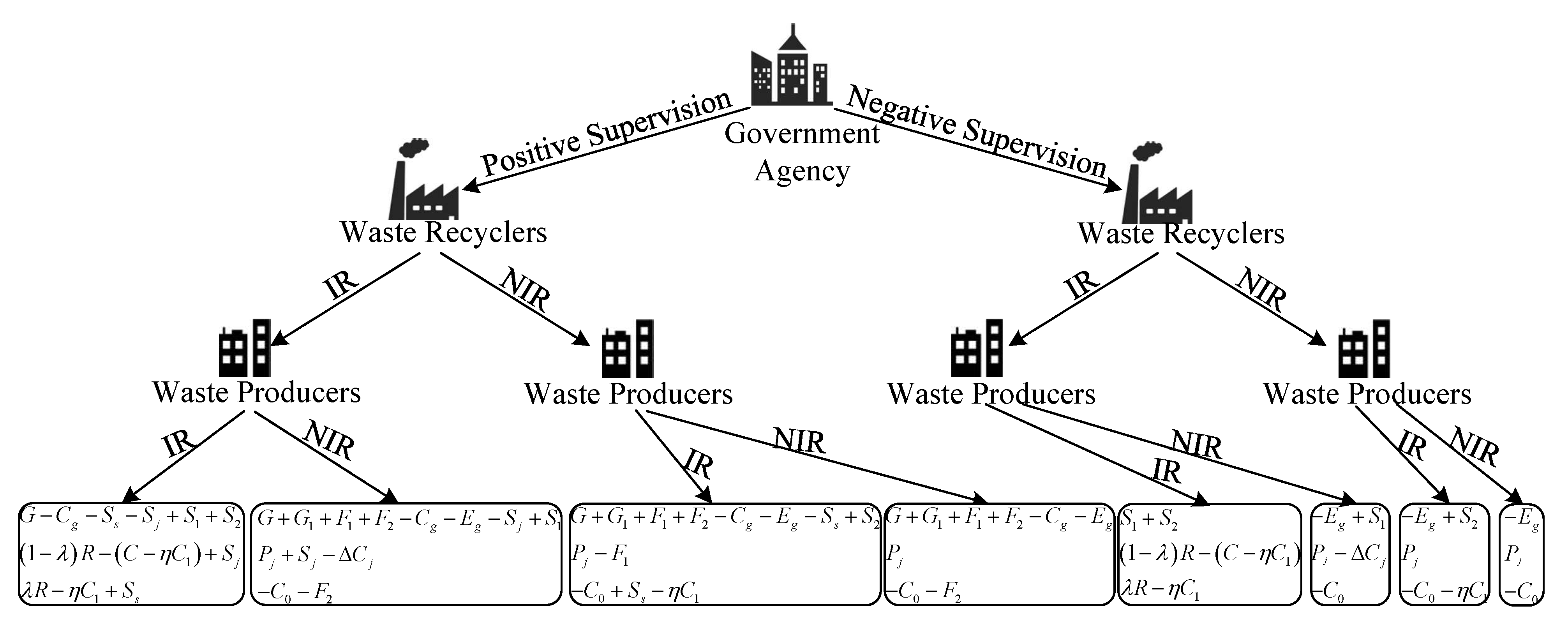
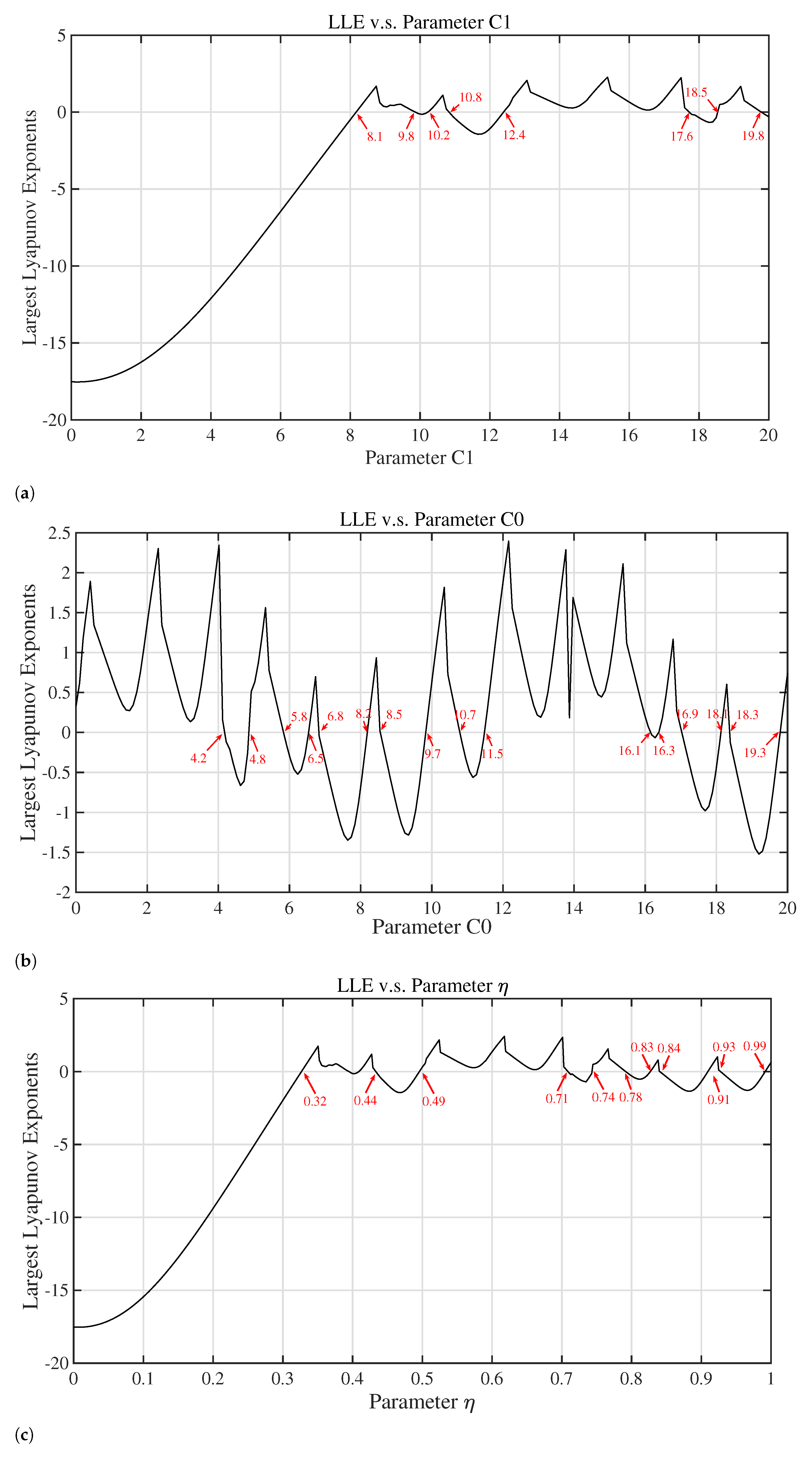
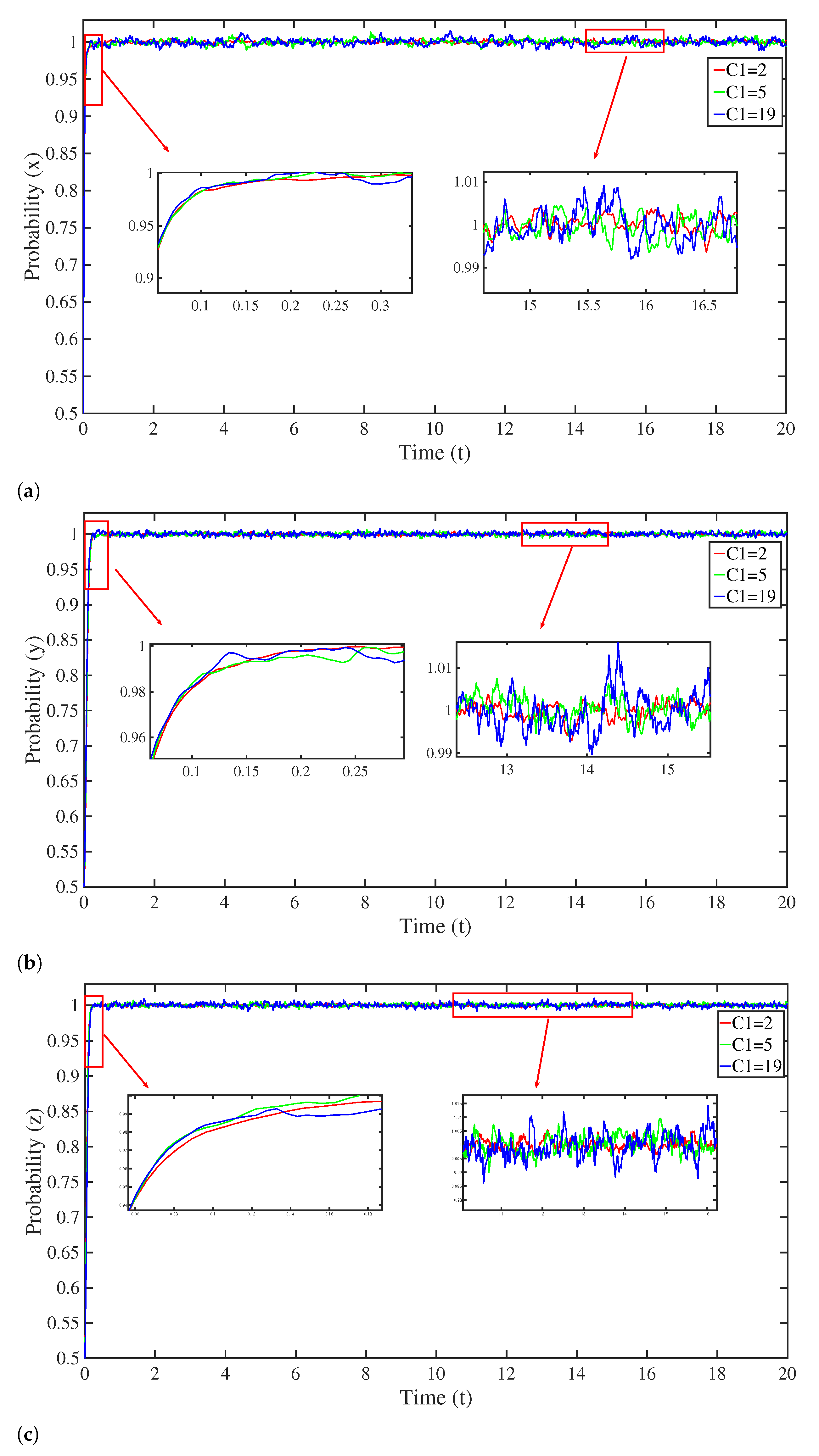

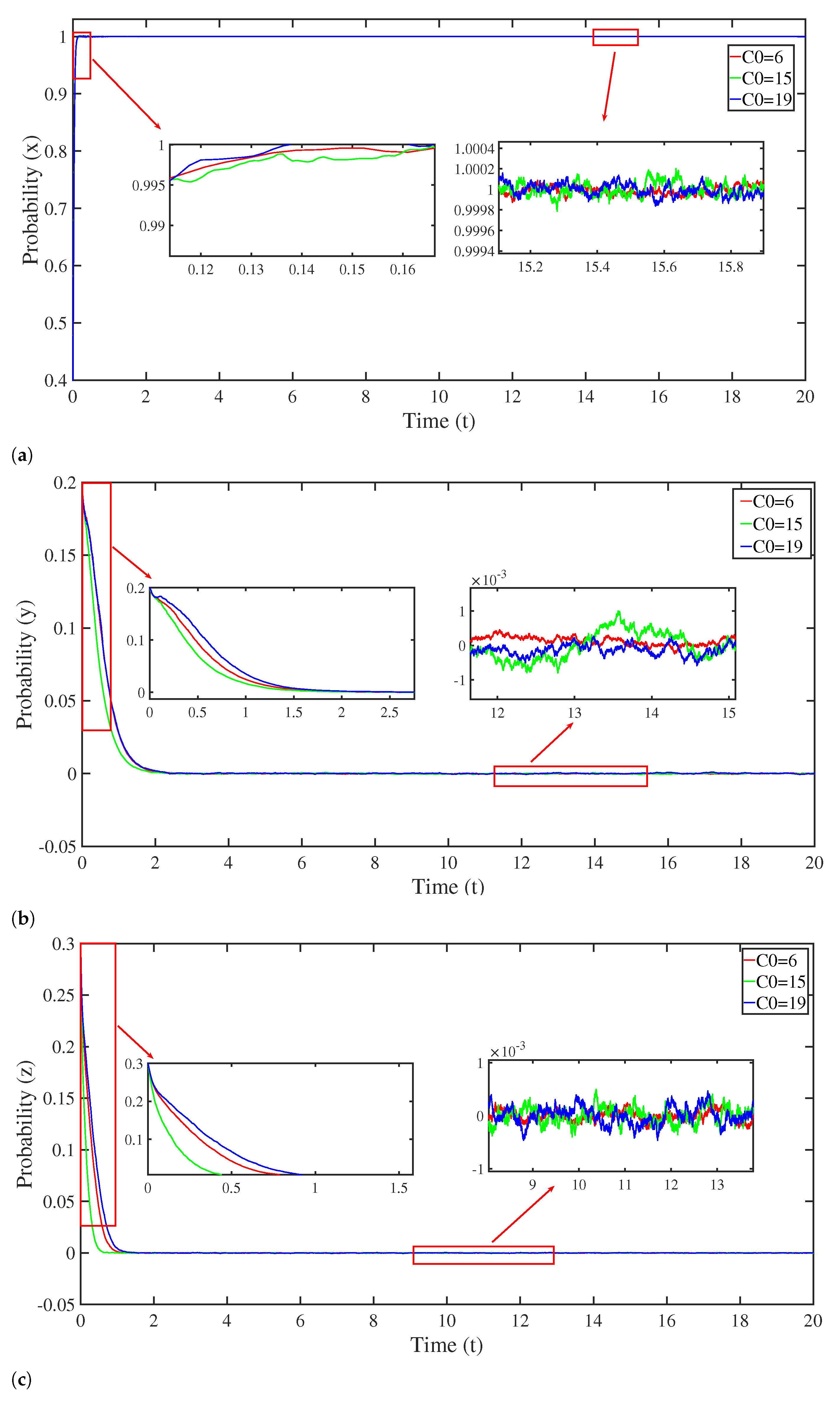
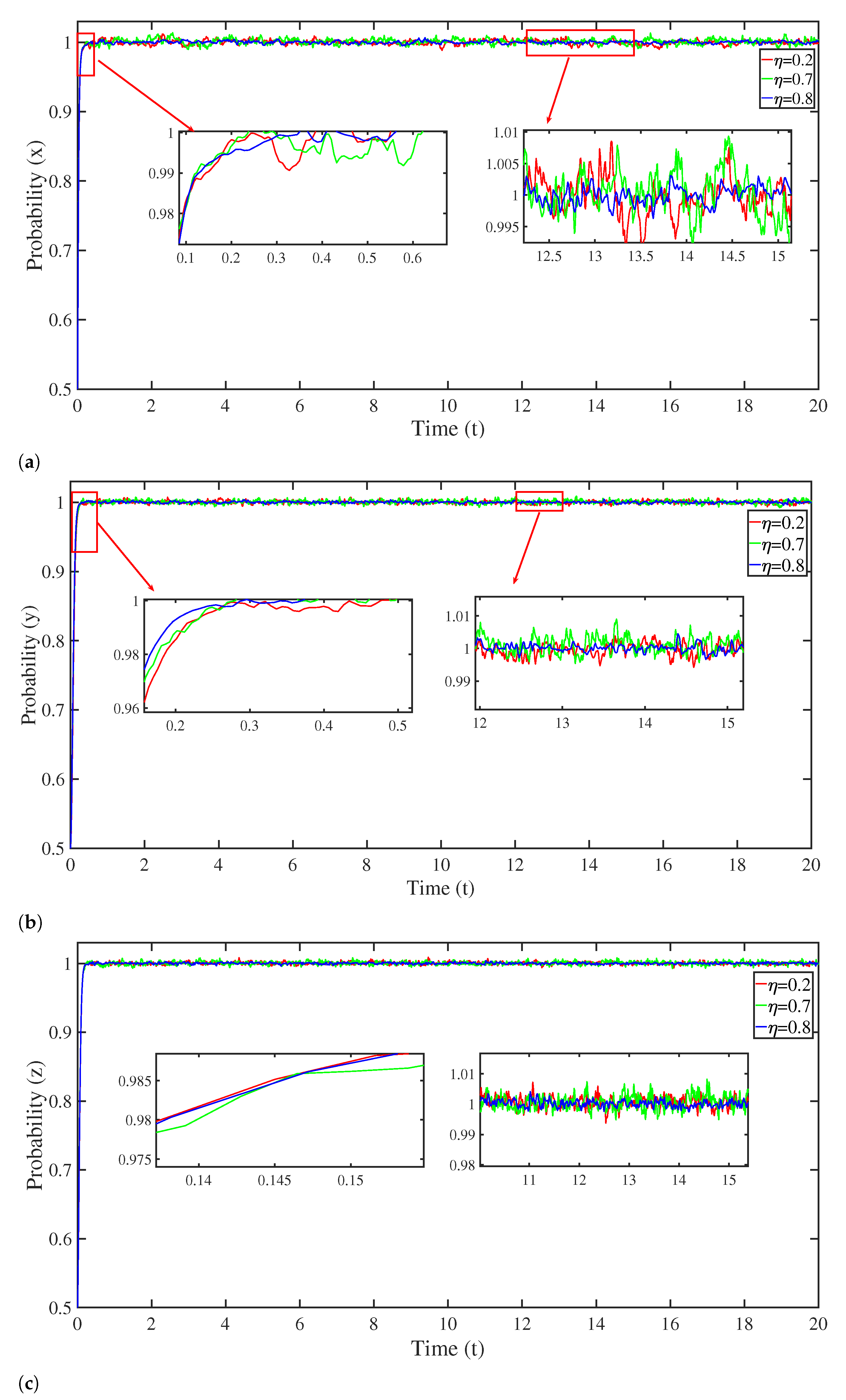
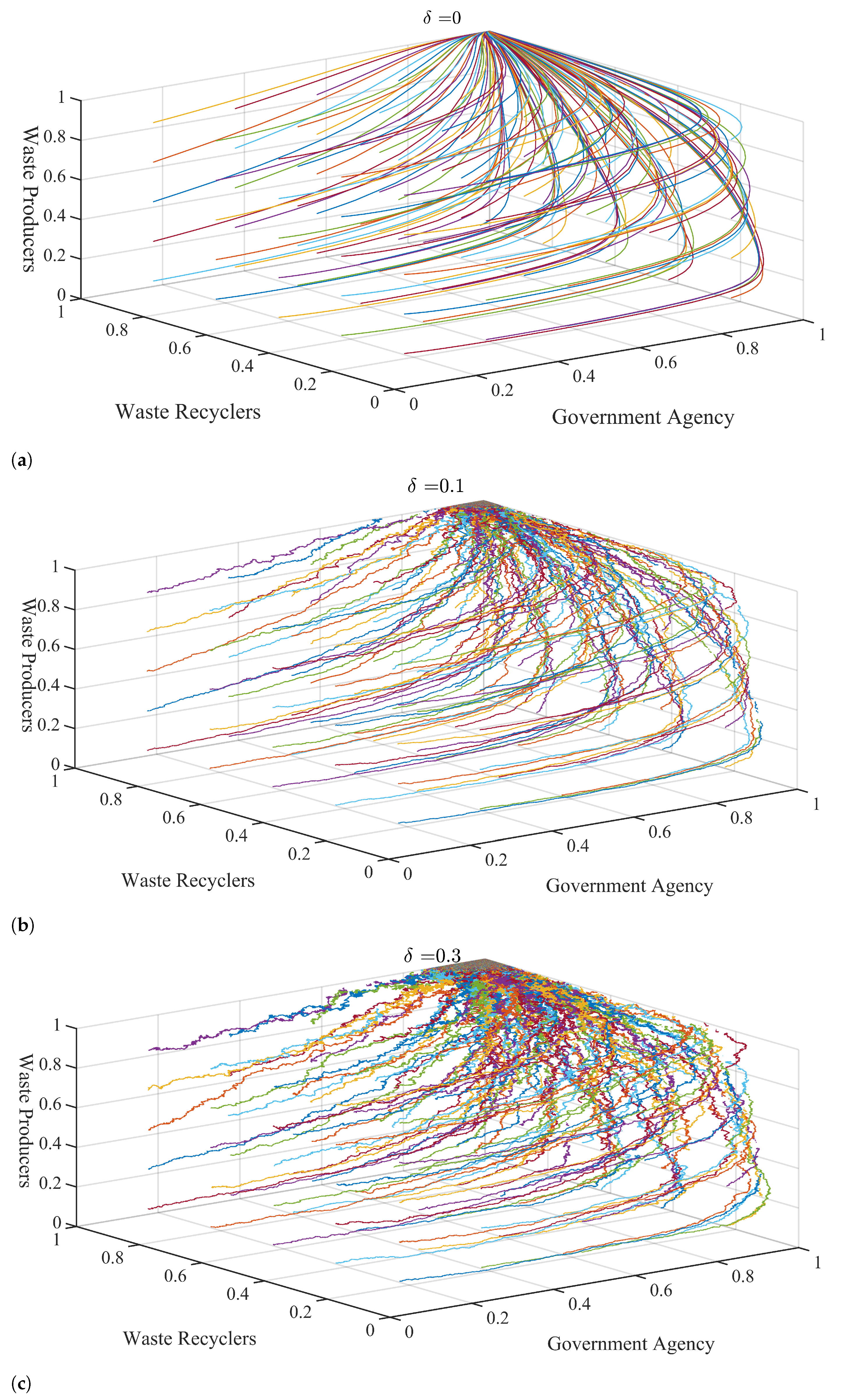
| Para. | Descriptions |
|---|---|
| If waste recyclers and producers do not implement construction waste recycling, then waste producers need to send the produced construction wastes to landfill for disposal, and the cost is , where . | |
| The waste recyclers generate construction materials by using natural materials, and the benefits is , where . | |
| The environment governance cost is paid by government agencies if the waste recyclers and producers do not implement construction waste recycling, where . | |
| Revenue distribution factor if waste recyclers and waste producers adopt construction waste recycling, where . | |
| R | Total revenue if waste recyclers and producers adopt waste recycling, . |
| Effort level when waste producers implement construction waste recycling. (). | |
| C | C Total costs of the entire recycling procedure from sorting to re-production (). |
| Sorting cost of construction waste (). | |
| Supervision cost of government agencies (). | |
| The losses if waste producers do not implement construction waste recycling while the waste recyclers adopt construction waste recycling strategies. | |
| G | Social benefits were achieved when the government conducted positive supervision, e.g, good reputation. |
| Environment benefits brought by the waste recyclers implement construction waste recycling, such as environmental improvement, etc. | |
| Environment benefits brought by the waste producers implement construction waste recycling, such as environmental improvement, etc. | |
| Good reputation achieved by government agency although their positive supervision cannot effectively evade construction waste generation. | |
| Subsidies offered by the government agencies to waste producers when it implements waste recycling. | |
| Subsidies provided by GA to waste recyclers when it implements waste recycling. | |
| Penalties are issued by GA to waste recyclers when it does not implement waste recycling. | |
| Penalties are issued by GA to waste producers when it does not implement waste recycling, where | |
| x | The probability when government agency conducting positive supervision. |
| y | The probability that waste recyclers conduct construction waste recycling. |
| z | The probability that waste producers implement construction waste recycling. |
| Waste Producer | |||||
|---|---|---|---|---|---|
| Implement Recycling z | Not Implement Recycling | ||||
| Government Agency | Positive Supervision x | Waster Recyclers | Implement Recycling y | () | |
| Not Implement Recycling | |||||
| Negative Supervision | Waster Recyclers | Implement Recycling y | |||
| Not Implement Recycling | |||||
Publisher’s Note: MDPI stays neutral with regard to jurisdictional claims in published maps and institutional affiliations. |
© 2022 by the authors. Licensee MDPI, Basel, Switzerland. This article is an open access article distributed under the terms and conditions of the Creative Commons Attribution (CC BY) license (https://creativecommons.org/licenses/by/4.0/).
Share and Cite
Sun, Y.; Gu, Z. Implementation of Construction Waste Recycling under Construction Sustainability Incentives: A Multi-Agent Stochastic Evolutionary Game Approach. Sustainability 2022, 14, 3702. https://doi.org/10.3390/su14063702
Sun Y, Gu Z. Implementation of Construction Waste Recycling under Construction Sustainability Incentives: A Multi-Agent Stochastic Evolutionary Game Approach. Sustainability. 2022; 14(6):3702. https://doi.org/10.3390/su14063702
Chicago/Turabian StyleSun, Ying, and Zhaolin Gu. 2022. "Implementation of Construction Waste Recycling under Construction Sustainability Incentives: A Multi-Agent Stochastic Evolutionary Game Approach" Sustainability 14, no. 6: 3702. https://doi.org/10.3390/su14063702
APA StyleSun, Y., & Gu, Z. (2022). Implementation of Construction Waste Recycling under Construction Sustainability Incentives: A Multi-Agent Stochastic Evolutionary Game Approach. Sustainability, 14(6), 3702. https://doi.org/10.3390/su14063702







